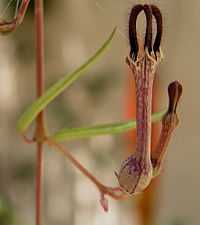Ceropegia
| Ceropegia | |
|---|---|
 | |
| Ceropegia distincta var haygarthii | |
| Scientific classification | |
| Kingdom: | Plantae |
| (unranked): | Angiosperms |
| (unranked): | Eudicots |
| (unranked): | Asterids |
| Order: | Gentianales |
| Family: | Apocynaceae |
| Subfamily: | Asclepiadoideae |
| Genus: | Ceropegia L. |
| Species | |
|
See text. | |
Ceropegia is a genus of plants within the family Apocynaceae. It was named by Carl Linnaeus, who first described this genus in volume 1 of his Species plantarum, which appeared in 1753. Linnaeus thought that the flowers looked like a fountain of wax. From this the scientific name was derived: ‘keros’ meaning wax and ‘pege’ meaning fountain (Pooley, 1998). They have many common names including lantern flower, parasol flower, parachute flower, bushman’s pipe, string of hearts, snake creeper, wine-glass vine, rosary vine, and necklace vine.
Ceropegia species have attracted much attention from botanists, horticulturalists, gardeners and succulent plant enthusiasts. Numerous species are commercially available and grown as ornamental houseplants. They can be propagated by seed and cuttings.
Appearance
The stems are vining or trailing in most species, though a few species from the Canary Islands have erect growth habits. Among some species, such as Ceropegia woodii, the nodes swell, and the roots similarly expand to form tubers beneath the soil surface. The leaves are simple and opposite, although they can be rudimentary or absent. Especially in certain succulent species, the leaves may also be thick and fleshy.The flowers have a tubular corolla with five petals most often fused at the tips, forming an umbrella-like canopy, a cage, or appendage-like antennae (Dyer, 1983). An interesting feature of Ceropegias is that their flower tubes are lined with small hairs that point downward to form a temporary trap for small flies. When flies are attracted into the flower by the odour they are prevented from escaping until the hairs wither, the pollinia of the Ceropegia flower being attached to the flies’ bodies when they escape.
Classification
The genus Ceropegia belongs to the Asclepiadoideae (Milkweed) sub-family within the family Apocynaceae. Species of this genus bear similarities to the carrion flowers or Stapelias. There are between 160 and 200 species worldwide and they are found widely from the Canary Islands, Africa, Madagascar, Arabia, India, Sri Lanka, southern China, Indonesia, the Philippines, New Guinea and Queensland.
A generic complex, with many interesting taxonomic problems at both generic and specific level, is formed by three genera: Ceropegia, Brachystelma and Riocreuxia.
Selected species

|
|
Gallery
-

Ceropegia stapeliiformis
-

References
Dyer, R.A. 1983. Ceropegia, Brachystelma and Riocreuxia in Southern Africa. A.A. Balkema, Rotterdam.
Pooley, E. 1998. A field guide to Wild Flowers KwaZulu-Natal and the Eastern Region. Natal Flora Publications Trust, Durban.
External sources
| Wikimedia Commons has media related to Ceropegia. |
